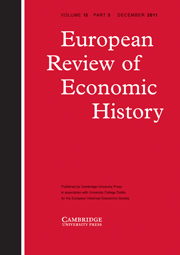Article contents
Contra Ricardo: On the macroeconomics of pre-industrial economies
Published online by Cambridge University Press: 07 September 2006
Abstract
The Ricardian model that inspires the conventional account of pre-industrial economic history assumes that productive opportunities are fully exploited, and that economic growth and fluctuations reflect the interaction of technological improvement, diminishing returns to labour and capital, and homeostatic demographic responses to changes in per capita income. This article argues that the long swings in output and productivity were the consequence of endogenous variation in trading costs affecting the profitability of undertaking specialised investment in market production. Because its markets were often ‘thin’, the pre-industrial economy possessed latent reserves of productivity that were not fully exploited. A search-equilibrium model is developed to demonstrate how such an economy could experience swings in output and productivity in the absence of technological or other ‘fundamental’ changes. The argument is supported by evidence indicating that the level of output in the second century may have approached that of the early eighteenth century.
‘For those who care for the overmastering pattern, the elements are evidently there for a heroically simplified version of English history before the nineteenth century in which long-term movements in prices, in income distribution, in investment, in real wages, and in migration are dominated by changes in the growth of population’. – H. J. Habakkuk (1958).
‘We may say broadly that while the part which nature plays in production shows a tendency to diminishing return, the part which man plays shows a tendency to increasing return’. – Alfred Marshall.
- Type
- Articles
- Information
- Copyright
- Cambridge University Press 1999
- 31
- Cited by


